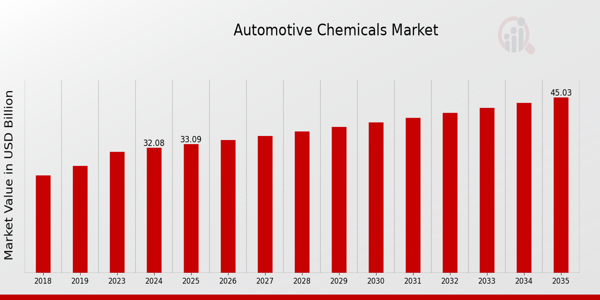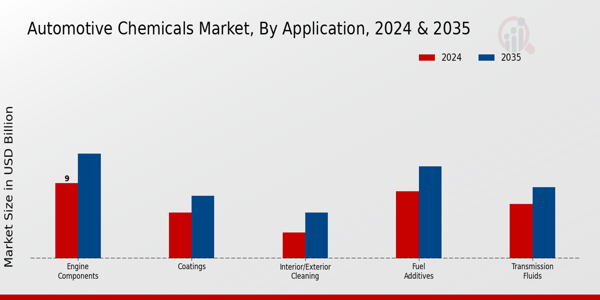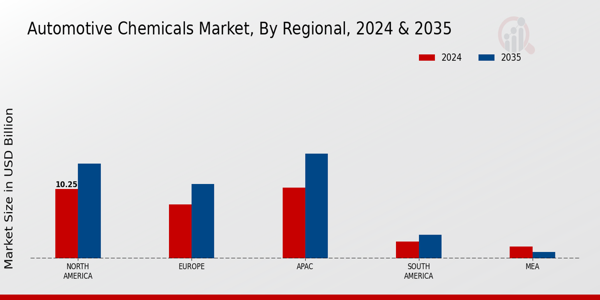Global Automotive Chemicals Market Overview
The Automotive Chemicals Market Size was estimated at 31.11 (USD Billion) in 2023. The Automotive Chemicals Industry is expected to grow from 32.08(USD Billion) in 2024 to 45 (USD Billion) by 2035. The Automotive Chemicals Market CAGR (growth rate) is expected to be around 3.13% during the forecast period (2025 - 2035).
Key Automotive Chemicals Market Trends Highlighted
The Automotive Chemicals Market is enduring significant transformations, which are being driven by a diverse array of market drivers. The adoption of alternative materials that reduce the environmental impact of automotive production is a significant factor that the growing emphasis on sustainability and eco-friendliness in vehicle manufacturing has prompted. This transition is further supported by regulatory initiatives that are intended to promote the adoption of environmentally favorable technologies and reduce carbon emissions. In response to the growing demand for lightweight vehicles, automotive manufacturers are also being compelled to investigate advanced materials and chemical formulations that improve fuel efficiency and performance.
The increasing prevalence of electric vehicles (EVs) and hybrid vehicles presents an opportunity for exploration, as they require specialized compounds for battery production and maintenance. Electric vehicles (EVs) are becoming increasingly prevalent, which has led to a new segmentation in the automotive chemicals market. This has generated opportunities for innovation in battery chemistries and other related products. Furthermore, the growing trend of automation in vehicle manufacturing is exacerbating the need for high-performance adhesives, sealants, and coatings that can withstand the rigorous demands of contemporary production processes. Recent trends, such as the proliferation of digital technology and smart manufacturing, are also influencing the market landscape.

Source: Primary Research, Secondary Research, MRFR Database and Analyst Review
Automotive Chemicals Market Drivers
Increasing Vehicle Production and Sales Worldwide
The increase in vehicle production and sales across various regions significantly drives the Automotive Chemicals Market Industry. According to data from the International Organization of Motor Vehicle Manufacturers, vehicle production reached approximately 95 million units in 2022, representing a considerable increase compared to previous years. As vehicle manufacturers ramp up production to meet growing consumer demand, the need for automotive chemicals, including adhesives, coatings, and sealants, rises proportionately.
With major automotive companies like Toyota and Volkswagen investing heavily in new production facilities and expanding existing ones, it further stimulates the demand for automotive chemicals. For example, Toyota announced a new facility in the United States aiming to produce over 1 million vehicles annually, reinforcing the growth trajectory of the Automotive Chemicals Market Industry. This production boost directly correlates with a higher requirement for automotive chemicals, thereby influencing market growth positively.
Advancements in Electric and Hybrid Vehicles
The transition towards electric and hybrid vehicles (EVs and HEVs) presents a substantial opportunity for the Automotive Chemicals Market Industry as these vehicles require specific chemicals for various applications. Reports indicate that sales of electric vehicles are anticipated to reach 30 million units by 2030, reflecting a sharp increase from current figures. Major manufacturers such as Tesla and Nissan are investing heavily in Research and Development to innovate battery technologies that demand unique automotive chemicals.
For instance, Tesla’s commitment to reducing battery production costs emphasizes the need for advanced chemical solutions that enhance performance and efficiency, thus promoting the Automotive Chemicals Market Industry. With government initiatives supporting the transition to cleaner energy, the demand for specialized automotive chemicals in EVs will continue to rise.
Stringent Environmental Regulations
Another pivotal driver impacting the Automotive Chemicals Market Industry is the implementation of stringent environmental regulations aimed at reducing emissions and promoting sustainability in automotive manufacturing. With governments around the world establishing stricter guidelines on volatile organic compounds (VOCs) and hazardous materials, automotive manufacturers are compelled to adapt by utilizing eco-friendly chemicals in their production processes.
The United States Environmental Protection Agency has laid down regulations that require automotive coatings to decrease VOC emissions by 30% within specific deadlines. This regulatory landscape not only encourages the development and use of sustainable automotive chemicals but also positions companies that specialize in green chemistry favorably within the Automotive Chemicals Market Industry. Manufacturers are increasingly partnering with chemical suppliers to innovate in compliance with regulations, enhancing the appeal of their vehicles in an environmentally conscious market.
Automotive Chemicals Market Segment Insights
Automotive Chemicals Market Application Insights
The Automotive Chemicals Market is anticipated to demonstrate significant growth across various applications, contributing to its overall valuation of 32.08 USD Billion by 2024. Within this market, a few applications have emerged as pivotal. Engine Components are expected to hold a major share, valued at 9.0 USD Billion in 2024 and projected to grow to 12.5 USD Billion by 2035, showcasing the importance of these chemicals in enhancing engine performance and efficiency. Transmission Fluids are also critical, valued at 6.5 USD Billion in 2024, with a forecast to increase to 8.5 USD Billion by 2035.
This application plays a significant role in the smooth operation of vehicles, providing lubrication, cooling, and protection to transmission systems. Fuel Additives will further contribute to the market, estimated at 8.0 USD Billion in 2024, with an expected rise to 11.0 USD Billion by 2035. This segment is vital for improving fuel efficiency and reducing emissions, making it a focus area for automotive manufacturers striving for sustainability. Coatings represent another essential application, valued at 5.5 USD Billion in 2024 and projected to reach 7.5 USD Billion by 2035.
The protective and aesthetic qualities of coatings are indispensable for vehicle longevity and consumer appeal. Interior and Exterior Cleaning chemicals are forecasted at 3.08 USD Billion in 2024, with anticipated growth to 5.5 USD Billion by 2035, emphasizing the importance of vehicle maintenance for consumer satisfaction and resale value. Overall, the Automotive Chemicals Market segmentation reflects the diverse application landscape, with growth driven by advancements in technology and increasing environmental regulations aiming for cleaner and more efficient automotive solutions.

Source: Primary Research, Secondary Research, MRFR Database and Analyst Review
Automotive Chemicals Market Type Insights
The Automotive Chemicals Market is a vital segment within the automotive industry, showcasing a diverse range of products categorized by Type. In 2024, the market is projected to be valued at 32.08 USD Billion, reflecting a significant need for these chemicals to enhance vehicle performance and longevity. Engine Oils play a critical role in maintaining engine efficiency and reducing wear, while Functional Fluids are essential for various vehicle systems, ensuring optimal function. Specialty Chemicals are increasingly gaining traction for their unique properties tailored to specific automotive applications.
Additives serve to enhance the performance characteristics of automotive fluids, making them a vital component in modern vehicles. Cleaners are imperative for maintaining vehicle aesthetics and functionality, supporting the overall market growth. As the industry adapts to changing regulations and sustainability concerns, innovation in these product Types is likely to drive the market's evolution. Increased vehicle production and advancements in automotive technologies are key contributors to the market's growth trajectory, emphasizing the importance of understanding the Automotive Chemicals Market segmentation for stakeholders.
Automotive Chemicals Market End-Use Insights
The Automotive Chemicals Market, valued at 32.08 billion USD in 2024, showcases a diverse segmentation in its End Use category, including Original Equipment Manufacturer (OEM), Aftermarket, and Recycling. The OEM segment holds a prominent position due to its critical role in the production of vehicles, where high-quality chemicals significantly enhance vehicle performance and safety. The Aftermarket segment also plays an essential part, as it addresses the increasing demand for vehicle maintenance and repair, driving demand for a variety of automotive chemicals.
Recycling is becoming increasingly significant in this landscape, reflecting growing awareness of sustainability and environmental concerns promoting the reprocessing of automotive chemicals. Overall, the growth drivers for these segments include rising automotive production, advancements in chemical formulations, and strict regulations promoting environmentally friendly practices. However, challenges such as fluctuating raw material prices and the need for continuous innovation persist. The Automotive Chemicals Market data shows that as automotive technologies evolve, the demand for advanced chemical solutions, particularly those supporting electronic and autonomous vehicles, will likely reshape this segment landscape, promoting further growth and diversification within the industry.
Automotive Chemicals Market Regional Insights
The Automotive Chemicals Market is expected to showcase significant growth across various regions, reaching a valuation of 32.08 USD Billion by 2024. North America holds a majority share, valued at 10.25 USD Billion in 2024. It is projected to grow to 14.0 USD Billion by 2035, primarily driven by the continuous advancement in automotive technology and a high demand for vehicle manufacturing. Europe follows closely, with a valuation of 8.0 USD Billion in 2024, increasing to 11.0 USD Billion by 2035, influenced by strict regulations promoting environmentally friendly automotive solutions.
The Asia-Pacific (APAC) region is also crucial, valued at 10.5 USD Billion in 2024 and expected to reach 15.5 USD Billion in 2035, largely due to the booming automotive industry in countries such as China and India. South America shows modest growth within the automotive chemicals market, starting at 2.5 USD Billion in 2024 and projected to reach 3.5 USD Billion by 2035, with a growing local automotive manufacturing base. Conversely, the Middle East and Africa (MEA) are forecasted to see a decline, with valuations of 1.8 USD Billion in 2024, decreasing to 1.0 USD Billion by 2035, facing challenges in establishing a robust automotive infrastructure.

Source: Primary Research, Secondary Research, MRFR Database and Analyst Review
Automotive Chemicals Market Key Players and Competitive Insights
The competitive landscape of the Automotive Chemicals Market is characterized by a diverse array of players, each contributing unique innovations and strengths. As vehicle manufacturers increasingly seek materials that enhance performance, safety, and environmental compliance, the demand for advanced automotive chemicals is steadily rising. Ongoing technological advancements, stringent regulatory requirements, and an increasing emphasis on sustainability drive the market. Companies within this sector are focusing on developing high-performance materials that facilitate improvements in fuel efficiency, durability, and overall vehicle aesthetics. Competitive strategies often involve collaborations, mergers and acquisitions, and the exploration of sustainable practices to gain a significant foothold in this dynamic market.
DuPont stands as a prominent entity in the Automotive Chemicals Market, utilizing its extensive expertise in material science to deliver innovative solutions. The company's strong market presence is bolstered by a robust portfolio of high-performance polymers and specialty chemicals tailored for automotive applications. DuPont's strengths lie in its commitment to research and development, enabling the continuous introduction of cutting-edge products that cater to modern automotive demands. This focus on innovation has positioned DuPont as a leader in providing solutions that enhance vehicle safety, reduce weight, and improve fuel efficiency. Moreover, the company's strategic partnerships across the automotive supply chain amplify its competitive edge, allowing for seamless integration of its products into various automotive manufacturing processes.
Cabot operates within the Automotive Chemicals Market with a focused approach to delivering high-performance materials, including carbon blacks and specialty compounds, which play a vital role in automotive applications. The company's strong presence in this market is underpinned by its dedication to quality and performance, establishing it as a trusted supplier among automotive manufacturers. Cabot's strengths include its ability to provide customized solutions that meet specific industry requirements alongside an efficient supply chain that ensures timely delivery of products. The company's commitment to sustainability drives its innovation in developing eco-friendly solutions aimed at reducing the environmental impact of automotive products. Additionally, Cabot has actively sought growth through strategic mergers and acquisitions, enhancing its capabilities and expanding its product offerings in the automotive sector, reinforcing its position as a key player on a scale.
Key Companies in the Automotive Chemicals Market Include
- DuPont
- Cabot
- ExxonMobil
- SABIC
- Lanxess
- Shell
- Sumitomo Chemical
- Ashland
- AkzoNobel
- Dow
- LyondellBasell
- BASF
- Westlake Chemical
- Honeywell
- Clariant
Automotive Chemicals Market Industry Developments
Recent developments in the Automotive Chemicals Market have showcased significant activity among key players. In September 2023, DuPont announced an expansion of its chemical production capabilities to meet the increasing demand for innovative automotive materials, particularly in electric vehicles. Meanwhile, Cabot has launched new carbon black products tailored for automotive applications, emphasizing sustainability and performance. ExxonMobil has entered into strategic partnerships with OEMs to enhance fuel efficiency through advanced chemical formulations, while SABIC introduced a new range of polymers designed for lightweight automotive components in October 2023. Mergers and acquisitions have also been active; in August 2023, Lanxess acquired a specialty chemicals business to strengthen its automotive plastics segment. Sumitomo Chemical announced an acquisition of a competitor's business in September 2023 to expand its automotive chemical offerings. Additionally, significant market growth in the automotive chemicals sector is being driven by the shift towards electric vehicles and stringent regulations on emissions, affecting major companies like Shell and BASF, which are ramping up their Research and Development investments. Over the last few years, the market has shown robust expansion, marked by a compound annual growth rate that reflects rising automotive production and a focus on sustainable chemical solutions.
Automotive Chemicals Market Segmentation Insights
Automotive Chemicals Market Application Outlook
- Engine Components
- Transmission Fluids
- Fuel Additives
- Coatings
- Interior/Exterior Cleaning
Automotive Chemicals Market Type Outlook
- Engine Oils
- Functional Fluids
- Specialty Chemicals
- Additives
- Cleaners
Automotive Chemicals Market End-Use Outlook
- OEM
- Aftermarket
- Recycling
Automotive Chemicals Market Regional Outlook
- North America
- Europe
- South America
- Asia Pacific
- Middle East and Africa
|
Report Attribute/Metric
|
Details
|
|
Market Size 2023
|
31.11(USD Billion)
|
|
Market Size 2024
|
32.08(USD Billion)
|
|
Market Size 2035
|
45.0(USD Billion)
|
|
Compound Annual Growth Rate (CAGR)
|
3.13% (2025 - 2035)
|
|
Report Coverage
|
Revenue Forecast, Competitive Landscape, Growth Factors, and Trends
|
|
Base Year
|
2024
|
|
Market Forecast Period
|
2025 - 2035
|
|
Historical Data
|
2019 - 2024
|
|
Market Forecast Units
|
USD Billion
|
|
Key Companies Profiled
|
DuPont, Cabot, ExxonMobil, SABIC, Lanxess, Shell, Sumitomo Chemical, Ashland, AkzoNobel, Dow, LyondellBasell, BASF, Westlake Chemical, Honeywell, Clariant
|
|
Segments Covered
|
Application, Type, End Use, Regional
|
|
Key Market Opportunities
|
Electric vehicle chemical demand, Sustainable and eco-friendly products, Advanced coating technologies, Growth in automotive adhesives, Innovations in lightweight materials
|
|
Key Market Dynamics
|
growing automotive production, increasing demand for lightweight materials, stringent environmental regulations, rising innovation in coatings, expanding aftermarket services
|
|
Countries Covered
|
North America, Europe, APAC, South America, MEA
|
Frequently Asked Questions (FAQ) :
The Automotive Chemicals Market is expected to be valued at 32.08 USD Billion in 2024.
The Engine Components segment of the Automotive Chemicals Market is projected to be valued at 12.5 USD Billion in 2035.
North America is expected to hold the largest market share, valued at 10.25 USD Billion in 2024.
The expected CAGR for the Automotive Chemicals Market from 2025 to 2035 is 3.13%.
The Fuel Additives segment is projected to reach a value of 11.0 USD Billion by 2035.
Key players in the market include DuPont, ExxonMobil, SABIC, and BASF, among others.
The Coatings segment of the Automotive Chemicals Market is valued at 5.5 USD Billion in 2024.
The APAC region is projected to grow the fastest, with a value of 15.5 USD Billion by 2035.
The Interior/Exterior Cleaning segment is expected to reach 3.08 USD Billion in 2024.
The Transmission Fluids segment is projected to reach a market size of 8.5 USD Billion by 2035.

















